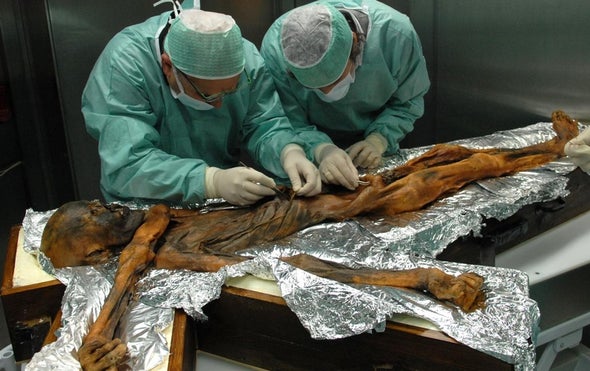A Post-Mortem For The Ages
"It [minute examination of 'Iceman's' stomach contents] was very impressive. We could see chunks and pieces of food with [the] naked eye."
"The stomach content is yellowish to brownish colored and mushy, with some bigger pieces of meat and grain."
"It wasn't the most hygienic of meals [given that fly remnants and long strands of goat hair were present]."
"It's a harsh environment [landscape of the frozen Alps]. They [ancient Europeans] had to be prepared. They had to have food that gave them the necessary energy [to survive a hostile environment and a long trek through a demanding geology]."
Frank Maixner, microbiologist, Institute for Mummy Studies, Bolzano, Italy
"They're [investigative scientists] trying to use all the methods in the toolbox to answer this really important question of what people [five thousand years ago in Europe] were eating [to sustain themselves in frozen atmospheres at high mountainous altitudes]."
Albina Hulda Palsdottir, archeozoologist, University of Oslo
 |
| This photograph was taken during the stomach content sampling campaign in November 2010 in Bolzano, Italy. Credit: South Tyrol Archaeology Museum, Eurac and M.Samadelli |
Initial examination revealed wounds thought to be have been inflicted in a violent confrontation with an adversary. He was judged to be about forty-five years of age when he died, likely from loss of blood linked to the mortal wounds he had sustained. From evidence discovered on his own weapons Oetzi did his utmost to defend himself; the blood of others also found.
He was named Oetzi, for the region where his body, encased in ice, was discovered by tourists. Italy succeeded in claiming him and he is kept in Bolzano, Italy. In 2009 the puzzle of his 'missing stomach' was solved when researchers discovered to their amazement, that after his death his stomach had shifted upward to remain undetected behind his rib cage.
Giving scientific enquiry the opportunity to examine that organ's contents answering the query, what was his, and others of his period, diet comprised of? A lot of fat, for energy, it would seem.
After the scientists had concluded their examination of Oetzi's stomach contents they published a paper describing their findings in the journal Current Biology to list the meat of a wild goat, its fat, meat of a red deer and whole wheat seeds, indicating that this was the last meal this human ate before his death.
Fern leaves and spores were discovered as well, items that the examining scientists feel may have been eaten without intention, or alternately as a medicinal for the parasites found on previous examination in his intestines.
 |
The 5,000-year-old mummy known as the Iceman was found in the Italian Alps in 1991.
Photograph from Vienna Report Agency/Sygma/Corbis
|
Labels: Human Evolution, Paleoarcheology, Research, Science

0 Comments:
Post a Comment
<< Home